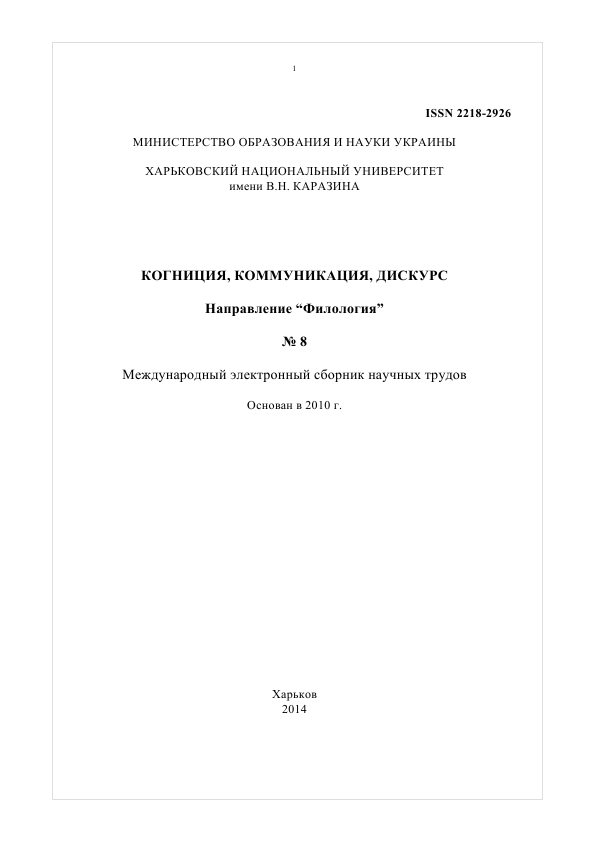Cognitive and communicative properties of MODESTY (based on the English-language discourse)
Abstract
The paper proposes a method of analysis of ethical linguocultural concept – a regulator of communicative behavior MODEST as an inseparable unity of the cognitive and communicative approaches. The method provides a base for coherent stages of analysis enabling to state lexical means of nominating the concept in English and its metaphorical actualization in discourse; to characterize conceptual, evaluative, image components of the concept and its properties as a member of the conceptual category VIRTUE; to structure the semantic space of the concept nominations; to schematize a frame structure of MODESTY; to describe the implementation of MODESTY in politeness strategies and tactics of Victorian discourse.
Downloads
References
Заика Т.В. Фразеологические средства репрезентации концепта "совесть" в современном английском языке: дис. ... канд. филол. наук: 10.02.04 / Заика Татьяна Васильевна. – Белгород, 2011. – 222 с.
Кошманова О.В. Концепт «скромность» в русской, американской и иранской лингвокультурах: дис. ... канд. филол. наук: 10.02.20 / Кошманова Ольга Вячеславовна. – Астрахань, 2007. – 271 с.
Кубрякова Е.С. Язык и знание: На пути получения знаний о языке: Части речи с когнитивной точки зрения. Роль языка в познании мира / Е.С. Кубрякова. – М.: Языки славянской культуры, 2004. -560 с.
Ларина Т.В. Категория вежливости и стиль коммуникации: Сопоставление английских и русских лингвокультурных традиций: монография / Т.В. Ларина. – М.: Языки славян.культур, 2009. – 512 с.
Мушаева О.К. Презентационные регулятивные концепты в калмыцкой, русской и английской лингвокультурах: автореф. дис. на соискание учен. степени канд. филол. наук: спец. 10.02.20 «Сравнительно-историческое, типологическое и сопоставительное языкознание» / Мушаева Ольга Константиновна. –Волгоград, 2008. –20 с.
Никитин М.В. Курс лингвистической семантики: учеб. пособие / М.В. Никитин. – [2-е изд., доп. и испр.]. – СПБ.: РГПУ им. А.В. Герцена, 2007. – 819 с.
Шевченко И.С. Концепты коммуникативного поведения и дискурс / И.С. Шевченко // Вюник Харюв. нац. ун-ту 1меш В.Н. Каразша. – 2013. – №1071.-С. 18-25.
Barnden J.A. Metaphor and Metonymy: Making Their Connections More Slippery / J.A. Barnden // Cognitive Linguistics. – 2010. – Vol. 21. – Issue 1. – P. 1–34.
Barcelona A. Metaphtonymy / A. Barselona // Cognitive Linguistics. – 1990. – № 3. – P. 323–340.
Brown P. Politeness: Some Universals in Language Use / P. Brown, S. Levinson. – NY.: CUP, 1987. – 345 p.
Croft W. Cognitive Linguistics / W. Croft, D. Cruse. – Cambridge: Cambridge University Press, 2004. – 356 p.
Himmelfarb G. The De-moralization of Society: From Victorian Virtues to Modem Values / G. Himmelfarb. – L.: IEA Health and Welfare Unit, 1995. – 314 p.
Kovecses Z. Metaphor: A Practical Introduction / Z. Kovecses. – Oxford: Oxford University Press, 2002. – 375 p.
Lakoff G. Women, Fire and Dangerous Things: What Categories Reveal about the Mind / G. Lakoff. – Chicago: University of Chicago Press, 1987. – 614 p.
WordNet ® 3.0. A Lexical Database for English [Электронный pecypc]. – Режим доступа: http://wordnet.princeton.edu/
Authors, who publish with this journal, accept the following conditions:
The authors reserve the copyright of their work and transfer to the journal the right of the first publication of this work under the terms of the Creative Commons Attribution License (CC BY), which allows other persons to freely distribute a published work with mandatory reference to the authors of the original work and the first publication of the work in this journal.
Authors have the right to enter into separate additional agreements for the non-exclusive dissemination of the work in the form in which it was published by this journal (for example, to post the work in the electronic institutions' repository or to publish as part of a monograph), provided that the link to the first publication of the work in this journal is given.
The journal policy allows and encourages the authors to place the manuscripts on the Internet (for example, in the institutions' repositories or on personal websites), both before the presentation of this manuscript to the editorial board and during review procedure, as it contributes to the creation of productive scientific discussion and positively affects the efficiency and dynamics of citing the published work (see The Effect of Open Access).




